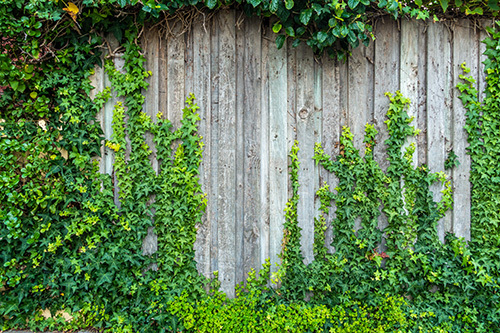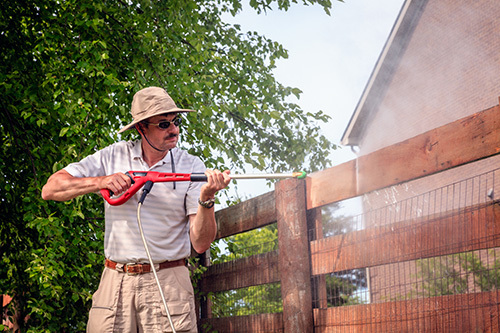How to Care for Wooden Fences
Best Practices for Wood Fence Protection
Summers in New England are hot and humid. Combined with the amount of rainfall that typically occurs in the spring, many aspects of your property might need extra care during the summer heat, and your fence is not an exception.
That is especially true if your fence is made of wood—from color-fading to rotting, protecting your fence from the environmental impacts of the warm and rainy season is important if you want to keep it functional and attractive for many years. While natural weathering will still take place, the process can be slowed with a proper maintenance. Read on for some light maintenance tips to help protect your fence this season.
1. Fix the Obvious
The first step in fence maintenance is checking your fence for:
- Obvious cracks or holes in the wood
- Splintering
- Warping
- Rotting
- Leaning
Given that your fence is still in good overall shape, small holes and cracks can be DIY filled with wood or putty fillers, whereas warping or splintering is best fixed by replacing panels and boards. It’s important to repair problems promptly, while they are still minor, to avoid further worsening.
Moreover, if your fence is decaying, even small amounts of deterioration can lead to a much larger problem, leaving your yard completely fenceless. This is why you want to replace rotted fence posts or boards as soon as possible. If the rot is caused by fungus, replacing the wood is the only way to help prevent the rot from spreading. Remained unfixed, posts or panels that have begun to splinter and rot may also reduce the overall strength of the entire fence.
2. Remove Vegetation

Although vines and greenery provide a nice decorative element to fencing, in some cases—depending on where the vegetation is located—the spring rains and dew can build up in the leave and debris, constantly exposing your fence to damaging moisture. Additionally, insects and rodents (that love this wood) can start nesting in it or chew through it.
To keep your fence safe, make sure that vegetation is not too close to it. Large and overhanging trees should be pruned to avoid them from falling onto your fence or breaking it. To err on the side of caution, trim your grass and weeds near your fence. The simple maintenance upfront more than makes up for the time and expense you’ll need to invest in fixing damaged fences.
3. Power-Wash
Power-washing a fence will help you clean off any mold, mildew, or algae buildups. As the temperature rises, these conditions tend to worsen, so it’s a good practice to treat your fence to a thorough pressure-washing before the weather gets too hot. Difficult areas can be cleaned by hand with soapy water and a hose.

Importantly, power-washing is a prep step prior to staining a fence. It helps to safely strip old finishes, including stains and peeling paint, and opens wood pores for deep penetration of stain or finish. Once your fence has been thoroughly power-washed and cleaned, allow the surface to dry for at least a few days before applying any stain or finish.
4. Stain & Finish
Staining and finishing your wooden fence before it is exposed to destructive elements for extended lengths of time is perhaps the most important fence-maintenance tip. During summer, the sun’s UV rays dry out the wood’s natural oils, while the water from summer rains gets absorbed into the inner cells of the wood, causing rotting. Staining your wood fence keeps the water from absorbing into the wood, protecting the inner cells, allowing them to retain their natural strength. This is why staining wood fences is so critical in retaining the integrity and longevity of your wood fence.
What is the proper time frame for staining a fence? If you have just installed a fence, it’s best to wait a few weeks before staining it. For example, cedar fences can take up to five weeks to dry out before staining. After that, you can apply a wood brightener to restore the red color and proceed to staining. Once the wood is stained, finish it with a sealant such as polyurethane that will render wood resistant to sunlight, heat, and water. Work your fence maintenance into your outdoor summertime activities—it will definitely pay off in the long term.
Choose the Right Wood Material: Cedar
If you are thinking of replacing your old fence completely, perhaps the best way to ensure your wooden fence lasts as long as possible is to choose the right wood material. Cedar is one of the best naturally rot-resistant woods that endures our northern climate—up to three times better than any other type of wood and can last for upwards of 20 years with proper care. AVO is one of the only local suppliers of cedar lumber in southeastern MA. We specialize in quality northern white cedar at affordable prices. Our inventory includes an array of options for wood grade, thickness, and type of cut. The best part of it is that when you buy your lumber directly from the source (that’s us!), you’ll have more options to choose from while saving money. Take a look now and plan some summer activities in your yard!

